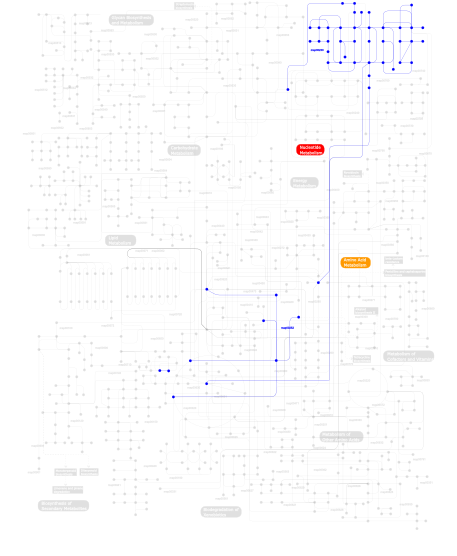Adenylsucc_syntAdenylosuccinate synthetase |
|---|
| SMART accession number: | SM00788 |
|---|---|
| Description: | Adenylosuccinate synthetase plays an important role in purine biosynthesis, by catalyzing the GTP-dependent conversion of IMP and aspartic acid to AMP. Adenylosuccinate synthetase has been characterized from various sources ranging from Escherichia coli (gene purA) to vertebrate tissues. In vertebrates, two isozymes are present - one involved in purine biosynthesis and the other in the purine nucleotide cycle. The crystal structure of adenylosuccinate synthetase from E. coli reveals that the dominant structural element of each monomer of the homodimer is a central beta-sheet of 10 strands. The first nine strands of the sheet are mutually parallel with right-handed crossover connections between the strands. The 10th strand is antiparallel with respect to the first nine strands. In addition, the enzyme has two antiparallel beta-sheets, comprised of two strands and three strands each, 11 alpha-helices and two short 3/10-helices. Further, it has been suggested that the similarities in the GTP-binding domains of the synthetase and the p21ras protein are an example of convergent evolution of two distinct families of GTP-binding proteins (PUBMED:8244965). Structures of adenylosuccinate synthetase from Triticum aestivum and Arabidopsis thaliana when compared with the known structures from E. coli reveals that the overall fold is very similar to that of the E. coli protein (PUBMED:10669609). |
| Interpro abstract (IPR001114): | Adenylosuccinate synthetase ( EC 6.3.4.4 ) plays an important role in purine biosynthesis, by catalysing the GTP-dependent conversion of IMP and aspartic acid to AMP. IMP and L-aspartate are conjugated in a two-step reaction accompanied by the hydrolysis of GTP to GDP in the presence of Mg2+. In the first step, the r-phosphate group of GTP is transferred to the 6-oxygen atom of IMP. An aspartate then displaces this 6-phosphate group to form the product adenylosuccinate. Adenylosuccinate synthetase has been characterised from various sources ranging from Escherichia coli (gene purA) to vertebrate tissues. In vertebrates, two isozymes are present: one involved in purine biosynthesis and the other in the purine nucleotide cycle. The crystal structure of adenylosuccinate synthetase from E. coli reveals that the dominant structural element of each monomer of the homodimer is a central beta-sheet of 10 strands. The first nine strands of the sheet are mutually parallel with right-handed crossover connections between the strands. The 10th strand is antiparallel with respect to the first nine strands. In addition, the enzyme has two antiparallel beta-sheets, comprised of two strands and three strands each, 11 alpha-helices and two short 3/10-helices. Further, it has been suggested that the similarities in the GTP-binding domains of the synthetase and the p21ras protein are an example of convergent evolution of two distinct families of GTP-binding proteins [ (PUBMED:8244965) ]. Structures of adenylosuccinate synthetase from Triticum aestivum and Arabidopsis thaliana when compared with the known structures from E. coli reveals that the overall fold is very similar to that of the E. coli protein [ (PUBMED:10669609) ]. |
| GO process: | purine nucleotide biosynthetic process (GO:0006164) |
| GO function: | adenylosuccinate synthase activity (GO:0004019), GTP binding (GO:0005525) |
| Family alignment: |
There are 22664 Adenylsucc_synt domains in 22661 proteins in SMART's nrdb database.
Click on the following links for more information.
- Evolution (species in which this domain is found)
- Cellular role (predicted cellular role)
- Literature (relevant references for this domain)
- Metabolism (metabolic pathways involving proteins which contain this domain)
- Structure (3D structures containing this domain)
- Links (links to other resources describing this domain)
















































